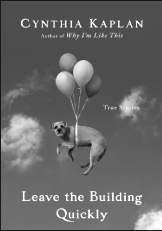By Rachel Fershleiser
It read:
“I really wanted my second book to be sharp and funny and snide and soulful and brave and heartbreaking and true. Unfortunately, that bitch Ann Leary wrote it first. I’d hate her guts except that I want to be her best friend.” — Cynthia Kaplan, author of Why I’m Like This
I laughed out loud. What woman doesn’t know that feeling, the one where jealousy and girlcrush entwine in a beautiful, awkward bow? I loved how the honesty and irreverence of those three pithy sentences belied genuine goodwill, and I reached for Cynthia Kaplan’s first book, “Why I’m Like This” immediately. It was a memoir in essays, billed as “true stories,” and it exemplified all the qualities Kaplan admired in Leary. The comparisons didn’t stop there; People magazine invoked both David Sedaris and Anna Quindlen.
Now, about three years after the inspired blurb, Kaplan’s second book is upon us. It’s called Leave the Building Quickly, and shares the “True Stories” subtitle with her first effort. Often sophomore literary endeavors fall short of their predecessors, and I admit I was apprehensive the author may have used up her best material. After all, how many truly engaging rants can one woman have in her before devolving to rehashed complaints?
The answer, I’m pleased to report, is at least two books’ worth. If anything, she is stronger in this new collection, perhaps emboldened by previous success, a few more years of life experience, or the screw-‘em-all exhaustion of parenting two young children. In her second book, Cynthia Kaplan adds heft to her humor, and joins the ranks of the great New Yorkers before her who have elevated neurosis to an art form.
In the titular piece, she ruminates on her fear and fantasies of dying in a fiery blaze. “After I had my first child,” she writes, “I imagined myself standing on our tiny terrace, screaming to the helicopter pilot that was hovering a few feet away, ‘Take my baby! Take my baby!’ as Marg Helgenberger, the prostitute-turned-mother did, in one of the final episodes of China Beach.” By the time that child, John, has entered kindergarten, he’s acquired his mother’s terror, and checks every room for a fire alarm before entering. “I like to think that the kind of compulsive fear to which I am susceptible is not something you instill in your children on purpose,” she explains, “You do it by accident, by being overprotective, jumpy, and singing them songs at bedtime about doomed farm animals.”
Not all Kaplan’s topics are treated as glibly as fire safety. Her rumination on the place of God in modern life is among the book’s strongest pieces, taking its inspiration from Rwandan genocide. Having retained an occasional belief in Judaism for years, (“I like bagels and lox and I like that my grandmothers called me Cindeluh.”) she is delivered the final straw in the form of a Don Cheadle movie (“What, exactly, is the point of a god who commands all these things — don’t kill, don’t hate, don’t steal blah blah blah — and people do it anyway, in droves, and then go to church or synagogue or mosque and get on their knees.”) After exploring cultural figures from Dionne Warwick to Martin Buber, she settles on the credo “Believe what you want to believe and don’t be an a**hole.”
This is where Kaplan’s most essential appeal lies — she is snarky and self-involved, but she never veers into a-hole territory. A sincere undercurrent of appreciation runs through her every quip and crack. And despite a small number of misses — if no one ever again makes the astute observation that teenage girls dress like whores on Halloween, it’ll be too soon — Kaplan’s writing is consistently clever and insightful. I’d hate her guts except that I want to be her best friend.


















